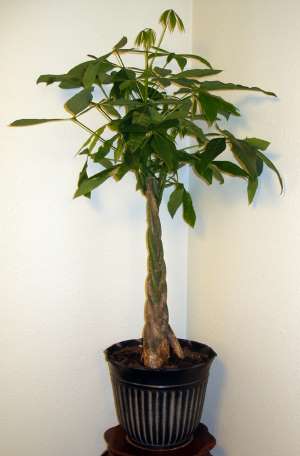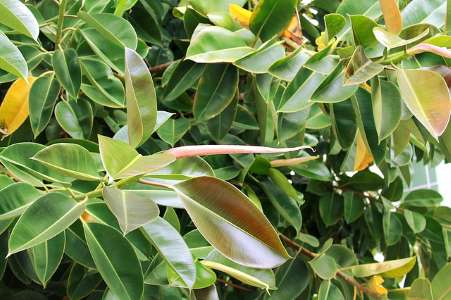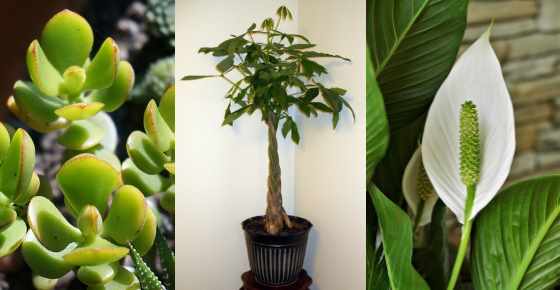There are several sorts of plants that Feng Shui considers as lucky flora, according to Feng Shui. Prosperity, fortune, love, and luck are all said to be brought by Feng Shui plants. As a result, certain sorts of lucky plants are known as money trees or money plants. Lucky bamboo, rubber plants, orchids, and several indoor ferns and palms are among the other plants Feng Shui considers to bring luck.
It’s a good idea to have a variety of houseplants, especially if you want to boost humidity and clean the air. Several plants, according to Feng Shui, expel bad energy and help to regulate the water element. Indoor plants may also help reduce stress, according to scientific studies.
Plants have a generally beneficial influence on a person’s mental health, according to other research. You’ll find out about Feng Shui lucky plants that may bring you luck, wealth, and even happiness in this piece.
Good Luck Plants to Bring Good Fortune, Wealth, and Health According to the Feng Shui
Starting with the money plant and tree, let’s take a closer look at the Chinese “lucky plants.”
Money Plant (Crassula Ovata)

According to Feng Shui, certain types of jade plants from the genus Crassula may bring good fortune and wealth. The money plant, dollar plant, cauliflower-ears, and money tree are all names for the jade plant species Crassula ovata. This Feng Shui plant’s coin-shaped leaves are said to represent prosperity. The Crassula ovata Feng Shui plant shouldn’t be confused with the actual money tree, Pachira aquatic.
It’s sometimes referred to as a money tree. Jade plants have tree-like stems, smooth branches, and thick fleshy leaves. They are a kind of succulent plant. Some cultivars have crimson or yellow edges, and the succulent leaves are jade green. These ovate leaves may grow to be 1.5 inches (4 cm) broad and up to 1 inch (3 cm) long.
Money plants may bloom in the winter if you’re lucky. Little star-shaped blooms with a sweet fragrance bloom white or pink. In the winter months, jade plants are more likely to bloom when the conditions are perfect. When nights are longer, the temperature is lower, and the plant isn’t getting water for a few weeks, this happens most frequently.
Money plants may reach up to 8 feet (2.5 meters) tall and resemble a huge shrub-like tree in certain cases. Indoor money plants, on the other hand, are unlikely to achieve these heights. The hardiness of jade plants is one of the reasons to keep them in the home, aside from hoping to increase your fortunes. Jade plants, like many succulents, are easy to care for and require little upkeep.
Jade plants are known to survive up to 100 years, according to certain studies. Money is frequently distributed to new business owners or put in workplaces to attract success and wealth. These money plants, which are also good houseplants, may help to create a natural, well-balanced indoor environment.
Money Tree Plant (Pachira Aquatica)

The money tree plant, sometimes known as the lucky plant (or lucky tree), is considered to bring good luck and prosperity. The genus Pachira belongs to the Malvaceae family of ornamental houseplants. Braided trunks growing in pots are frequently seen with images of this money tree plant (Pachira aquatic).
The money tree plant is said to attract luck, wealth, and success in the same way as jade plants do. Jade plants and the Pachira aquatica are not related in any way, which is one reason why they are also known as “money plants.”
According to mythology, a poor man prayed for money, and the money tree plant became an auspicious plant. This odd-looking plant happened to be in his path. When he began earning money selling the plants he nurtured from seeds, he considered it a lucky tree. Guiana Chestnut, French Peanut, Provision Tree, and Saba Nut are some of the names for this plant. The core stem is typically formed of three to seven intertwined stems as an ornamental Feng Shui lucky plant.
The stems are crowned with lance-shaped leaves that are quite glossy and green. Money trees typically reach a height of 3 to 6 feet (0.9 to 1.8 meters). Indoor money trees are usually sterile. To attract good fortune, prosperity, and wealth, Feng Shui followers place Pachira aquatica money trees in homes or businesses.
Lucky Bamboo (Dracaena Sanderiana)

Lucky bamboo is a Feng Shui plant that promises good luck and wealth, and it is believed to be an lucky plant in the home. Dracaena sanderiana is the Feng Shui lucky bamboo species. Chinese water bamboo, Goddess of Mercy, and Sander’s dracaena are some other names for this lucky charm houseplant.
This plant is not related to true bamboo Poaceae, despite its resemblance to bamboo. The plant features long, straight, fleshy stems with long leaves that make it an appealing decorative houseplant. Feng Shui prefers shorter variants of the bamboo-like plant, which may grow up to 3.2 feet (1 meter) tall.
Cut the stems back on your lucky bamboo every so often to keep it looking great. This will help the stalk and leaves continue to grow healthily by directing energy back into them. Pruning them on a regular basis and keeping them in modest containers will help keep the growth in check.
Lucky bamboo plants are usually sold in glass containers or pots with just rocks and water. Plants grow equally well in water as they do in dirt, according to research. Lucky bamboo is one of the toughest houseplants to maintain because of its low maintenance requirements.
If you use filtered water or rainwater, you can keep these lucky plants in just water by feeding them liquid fertilizer every month and avoiding topping up with tap water. When it comes to attracting luck, Feng Shui claims that the quantity of bamboo stalks has different meanings. Happiness, wealth, and long life are represented by three stalks, while wealth and good luck are represented by five or six. Furthermore, the number 7 may represent excellent health.
Rubber Plant (Ficus elastica)

Because it’s a lucky plant, adding beauty to your home by keeping an ornamental rubber plant indoors is said to bring luck. The Ficus elastica species is said to bring wealth, success, and good fortune according to Feng Shui. Rubber fig, Indian rubber bush, and rubber bush are some of the other names for this indoor good luck tree.
One of the many types of indoor ficus trees is the rubber tree plant. This beneficial luck is associated with figs, since it belongs to the Moraceae family. Large thick oval leaves in a variety of colors are found on ornamental rubber plants. Shiny green leaves are found on certain kinds of Ficus elastica, while variegated yellow or creamy-white while green leaves are found on others. Burgundy red leaves are also seen on other kinds.
Creating a natural, stress-free atmosphere in a space might be aided by strategically placing a rubber plant. The indoor rubber plant, which grows to be between 6 and 10 feet (180 and 300 cm) tall, is ideal for tiny spaces or workplaces. Plants with rounded leaves, such as the rubber plant, are believed to have good energy in Feng Shui.
Orchids

Orchids are a lucky plant that can be grown in your home, according to Feng Shui. They also increase family luck. Violet orchids are the luckiest plants, according to certain reports, out of thousands of varieties. Green-leaved types of shrubs or trees are common Feng Shui plants. As a result, orchids stand out as the luckiest of all the “lucky plants” on offer. In many cultures, orchids are seen as a symbol of love and beauty. They represent good luck, better connections, and increased fertility in Feng Shui.
There are hundreds of orchid cultivars and hybrids to choose from. Paphiopedilum and Phalaenopsis orchids are two of the most gorgeous orchids that are simple to care for. To enhance feelings of calm and peace, these may be decorated with plain white blooms. Orchids in bright colors can also communicate excitement, vigor, and inventiveness. The roots of the stem of most types of indoor houseplant orchids are covered in large, thick leaves.
The plant produces long stems from the middle and produces huge flowers along the length. The petals of many orchid blooms are oval-shaped or lance-shaped, and they may number five or more. Among the thousands of orchid hybrids, however, there are many variations. Orchids may be used to symbolize unity or as gifts for new families.
Peace Lilies (Spathiphyllum)

According to Chinese Feng Shui, peace lilies represent prosperity and good luck. Peace lilies are said to aid in the production of good luck and money, according to Feng Shui. Its beautiful white flowers and huge green leaves provide a lovely atmosphere in any room.
Peace lilies are considered a “good luck plant” by some people, who believe they’re an Feng Shui plants. Peace lilies were rated as one of the plants that improve air quality by NASA in 1989. According to the research, formaldehyde and benzene are eliminated from the air by clean-air plants like peace lilies.
These attractive plants aren’t true lilies from the Liliaceae family, despite having the word “lily” in their names. The genus Peace lilies belongs to the Araceae family of flowering leafy plants. The huge dark green leaves and pure white flowers are the most remarkable characteristics of lilies.
Its leaves may be up to 10 inches (25 cm) broad and can stretch up to 25 inches (65 cm). White flowers with a single petal, ranging from 4″ to 12″ (10 – 30 cm), are used to contrast these. Peace lilies may be used to improve air quality in any area. In offices or at work desks, they may be exceedingly beneficial.
Citrus Trees

Indoor ornamental citrus trees are considered lucky trees that can attract money and good luck
Growing citrus trees in containers indoors is another way to attract money, and good luck according to the Chinese Feng Shui. Lucky plants like citrus trees are claimed to bring good luck and prosperity to the home.
Some Feng Shui followers use citrus trees for their gardens. However, there are many ornamental orange, lemon, and lime trees that you can grow inside your house.
Little shrub-like plants that grow in little pots are known as indoor citrus trees. If you want a taller plant in a room, you can train a citrus tree to grow taller. Ornamental citrus plants may brighten up any area and are ideal for kitchens. Dwarf lime trees or lemon trees, according to Feng Shui, are the best citrus trees for luck.
Parlor Palm (Chamaedorea Elegans)

Indoor palms serve as an air purifier and to boost equilibrium, and they are a popular houseplant. The parlor palm (Chamaedorea elegans) is one of the nicest little palm types for home décor. The parlor palm is a beautiful palm variety that bears its botanical name. It’s also one of the most commonly grown houseplants in the world.
The parlor palm can grow up to 2 feet (60 centimeters) tall when grown indoors to help generate happy energy. Thin stems and large fern-like leaves characterize the shrubby plant. Parlor palms are so popular for a reason: they require very little upkeep. In low humidity, the plant seems to flourish as well as in high humidity. Other kinds of houseplants might not thrive in dark environments, whereas it can.
Parlor palms are versatile and can be used in any type of room, which is another reason why they are a good Feng Shui option. For example, light green leaves have a trailing nature, making them ideal for hanging baskets. They may be utilized to increase your living environment at front doors or anywhere else. You can also use a corner with a tall parlor palm to add sophistication to your home.
Boston Fern (Nephrolepis exaltata)

Boston ferns are a Feng Shui excellent luck plant that adds a feeling of optimism to any area, and they are another essential air purifying plant. This kind of fern is one of the most attractive plants you can have, and it’s also known as the sword fern, fishbone fern, or wild Boston fern.
The long trailing leaves of Boston ferns can add a touch of elegance to any room. The Feng Shui fern may grow to be between 40 and 90 cm tall. The fern fronds (leaves) may grow to be up to 8 feet (2.5 meters) long. Hang baskets or fill up space on top of a wardrobe, shelf, or plant stand with this big bushy plant.
Other Types of Plants Feng Shui Says Bring Good Luck

Snake plants, spider plants, and golden pothos are shown in the photograph (from left to right).
- Sansevieria Snake Plant It is said to bring good luck and also purify the air, and it is a kind of succulent with long sword-shaped leaves.
- Spider plants They also have the ability to relieve stress and boost concentration, in addition to having air-purifying properties.
- Golden pothos Another kind of lucky plant, Epipremnum aureum, is said to bring good luck to many people.
